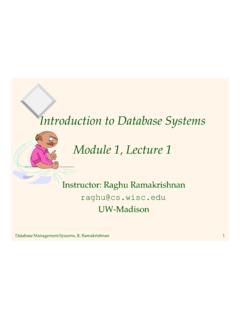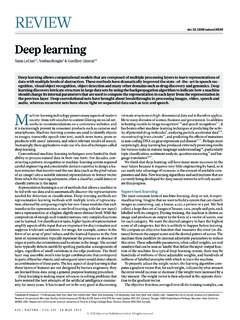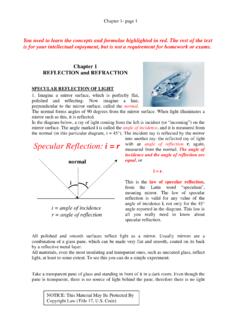Transcription of DATABASE MANAGEMENT SYSTEMS SOLUTIONS MANUAL …
1 DATABASE MANAGEMENTSYSTEMSSOLUTIONS MANUALTHIRD EDITIONR aghu RamakrishnanUniversity of WisconsinMadison, WI, USAJ ohannes GehrkeCornell UniversityIthaca, NY, USAJeff Derstadt, Scott Selikoff, and Lin ZhuCornell UniversityIthaca, NY, USACONTENTSPREFACEiii1 introduction TO DATABASE SYSTEMS12 introduction TO DATABASE DESIGN63 THERELATIONALMODEL164 relational ALGEBRA AND CALCULUS285 SQL: QUERIES, CONSTRAINTS, TRIGGERS456 DATABASE APPLICATION DEVELOPMENT637 INTERNET APPLICATIONS668 OVERVIEW OF STORAGE AND INDEXING739 STORING DATA: DISKS AND FILES8110 TREE-STRUCTURED INDEXING8811 HASH-BASED INDEXING10012 OVERVIEW OF QUERY EVALUATION11913 EXTERNAL SORTING12614 EVALUATION OF relational OPERATORS131iiiDatabase MANAGEMENT SYSTEMS SOLUTIONS MANUAL Third Edition15 A TYPICAL QUERY OPTIMIZER14416 OVERVIEW OF TRANSACTION MANAGEMENT15917 CONCURRENCY CONTROL16718 CRASH RECOVERY17919 SCHEMA REFINEMENT AND NORMAL FORMS18920 PHYSICAL DATABASE DESIGN AND TUNING20421 SECURITY215 PREFACEIt is not every question that deserves an Syrus, 42 hope that most of the questions in this book deserve an answer.
2 The set of questionsis unusually extensive, and is designed to reinforce and deepen students understandingof the concepts covered in each chapter. There is a strong emphasis on quantitativeand problem-solving type I wrote some of the SOLUTIONS myself, most were written originally by studentsin the DATABASE classes at Wisconsin. I d like to thank the many students who helpedin developing and checking the SOLUTIONS to the exercises; this MANUAL would not beavailable without their contributions. In alphabetical order: X. Bao, S. Biao, , C. Chan, W. Chen, N. Cheung, D. Colwell, J. Derstadt, C. Fritz, , J. Gehrke, G. Glass, V. Gopalakrishnan, M. Higgins, T. Jasmin, M. Krish-naprasad, Y. Lin, C. Liu, M. Lusignan, H. Modi, S. Narayanan, D. Randolph, , J. Reminga, A. Therber, M. Thomas, Q. Wang, R. Wang, Z. Wang andJ. Yuan. In addition, James Harrington and Martin Reames at Wisconsin and NinaTang at Berkeley provided especially detailed students contributed to each chapter s SOLUTIONS , and answers were subse-quently checked by me and by other students.
3 This MANUAL has been in use for severalsemesters. I hope that it is now mostly accurate, but I m sureit still contains er-rors and omissions. If you are a student and you do not understand a particularsolution, contact your instructor; it may be that you are missing something, but itmay also be that the solution is incorrect! If you discover a bug, please send me and I will update the MANUAL latest version of this SOLUTIONS MANUAL is distributed freely through the Web; goto the home page mentioned below to obtain a More InformationThe home page for this book is at URL:iiiDatabase MANAGEMENT SYSTEMS SOLUTIONS MANUAL Third ~dbbookThis page is frequently updated and contains information about the book, past andcurrent users, and the software. This page also contains a link to all known errors inthe book, the accompanying slides, and the the SOLUTIONS MANUAL isdistributed electronically, all known errors are immediately fixed and no list of errors are advised to visit this site periodically; they can also registerat this site to be notified of important changes by TO DATABASESYSTEMSE xercise would you choose a DATABASE system instead of simply storing datain operating system files?
4 When would it make sensenotto use a DATABASE system?Answer an integrated collection of data, usually so large that ithas to be stored on secondary storage devices such as disks or tapes. This data canbe maintained as a collection of operating system files, or stored in aDBMS(databasemanagement system). The advantages of using a DBMS are:Data independence and efficient application programs are in-dependent of the details of data representation and storage. The conceptual andexternal schemas provide independence from physical storage decisions and logicaldesign decisions respectively. In addition, a DBMS provides efficient storage andretrieval mechanisms, including support for very large files, index structures andquery application development the DBMS provides several impor-tant functions required by applications, such as concurrency control and crashrecovery, high level query facilities, etc., only application-specific code needs tobe written.
5 Even this is facilitated by suites of application development toolsavailable from vendors for many DATABASE MANAGEMENT integrity and view mechanism and the authorization facilitiesof a DBMS provide a powerful access control mechanism. Further, updates to thedata that violate the semantics of thedata can be detected and rejected by theDBMS if users specify the appropriateintegrity providing a common umbrella for a large collection ofdata that is shared by several users, a DBMS facilitates maintenance and dataadministration tasks. A good DBA can effectively shield end-users from the choresof fine-tuning the data representation, periodic back-ups 1 Concurrent access and crash DBMS supports the notion of atrans-action, which is conceptually a single user s sequential program. Users can writetransactions as if their programs were running in isolation against the DBMS executes the actions of transactions in an interleaved fashion to obtaingood performance, but schedules them insuch a way as to ensure that conflictingoperations are not permitted to proceed concurrently.
6 Further, the DBMS main-tains a continuous log of the changes to the data, and if there is a system crash,it can restore the DATABASE to atransaction-consistentstate. That is, the actionsof incomplete transactions are undone, so that the DATABASE state reflects only theactions of completed transactions. Thus,if each complete transaction, executingalone, maintains the consistency criteria, then the DATABASE state after recoveryfrom a crash is these advantages are not important for the application at hand, using a collection offiles may be a better solution because of the increased cost and overhead of purchasingand maintaining a is logical data independence and why is it important?Answer the difference between logical and physical data data independence means that users are shielded from changesin the logical structure of the data, while physical data independence insulates usersfrom changes in the physical storage of the data. We saw an example of logical dataindependence in the answer to Exercise Consider the Students relation from thatexample (and now assume that it is not replaced by the two smaller relations).
7 Wecould choose to store Students tuples in a heap file, with a clustered index on thesname field. Alternatively, we could choose to store it with an index on the gpa field,or to create indexes on both fields, or to store it as a file sorted by gpa. These storagealternatives are not visible to users, except in terms of improved performance, sincethey simply see a relation as a set of tuples. This is what is meant by physical the difference between external, internal, and conceptual sche-mas. How are these different schema layers related to the concepts of logical andphysical data independence?Answer are the responsibilities of a DBA? If we assume that the DBAis never interested in running his or her own queries, does the DBA still need tounderstand query optimization? Why? introduction to DATABASE Systems3 Answer DBA is responsible for:Designing the logical and physical schemas, as well as widely-used portions of theexternal and availability and recovery from tuning:The DBA is responsible for evolving the DATABASE , in particularthe conceptual and physical schemas, to ensure adequate performance as userrequirements DBA needs to understand query optimization even if s/he is not interested in run-ning his or her own queries because some of these responsibilities ( DATABASE designand tuning) are related to query optimization.
8 Unless the DBA understands the per-formance needs of widely used queries, and how the DBMS will optimize and executethese queries, good design and tuning decisions cannot be McNugget wants to store information (names, addresses, de-scriptions of embarrassing moments, etc.) about the many ducks on his payroll. Notsurprisingly, the volume of data compels him to buy a DATABASE system. To savemoney, he wants to buy one with the fewest possible features, and he plans to run it asa stand-alone application on his PC clone. Of course, Scrooge does not plan to sharehis list with anyone. Indicate which of the following DBMS features Scrooge shouldpay for; in each case, also indicate why Scrooge should (or should not) pay for thatfeature in the system he A security Concurrency Crash A view A query of the following plays an important role inrepresentinginforma-tion about the real world in a DATABASE ? Explain The data definition 12.
9 The data manipulation The buffer The data us discuss the choices in data definition language is important in representing information because itis used to describe external and logical data manipulation language is used to access and update data; it is notimportant for representing the data. (Of course, the data manipulation languagemust be aware of how data is represented, and reflects this in the constructs thatit supports.)The buffer manager is not very important for representation because it bringsarbitrary disk pages into main memory, independent of any data data model is fundamental to representing information. The data modeldetermines what data representation mechanisms are supported by the data definition language is just the specific set of language constructs availableto describe an actual application s data in terms of thedata the structure of a DBMS. If your operating system is upgradedto support some new functions on OS files ( , the ability to force some sequence ofbytes to disk), which layer(s) of the DBMS would you have to rewrite to take advantageof these new functions?
10 Answer the following questions:1. What is a transaction?2. Why does a DBMS interleave the actions of different transactions instead of exe-cuting transactions one after the other?3. What must a user guarantee with respect to a transaction and DATABASE consis-tency? What should a DBMS guarantee with respect to concurrent execution ofseveral transactions and DATABASE consistency?4. Explain the strict two-phase locking What is the WAL property, and why is it important? introduction to DATABASE Systems5 Answer us answer each question in turn:1. A transaction is any one execution of a user program in a DBMS. This is the basicunit of change in a A DBMS is typically shared among many users. Transactions from these userscan be interleaved to improve the execution time of users queries. By interleav-ing queries, users do not have to wait for other user s transactions to completefully before their own transaction begins. Without interleaving, if user A beginsa transaction that will take 10 seconds to complete, and user B wants to be-gin a transaction, user B would have to wait an additional 10 seconds for userA s transaction to complete before the DATABASE would begin processing user B A user must guarantee that his or her transaction does not corrupt data or insertnonsense in the DATABASE .
















